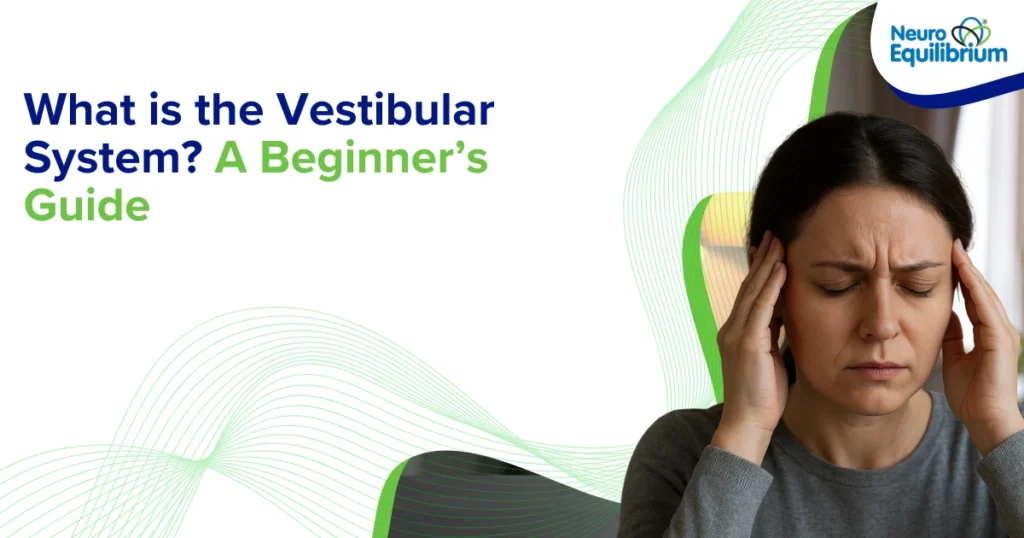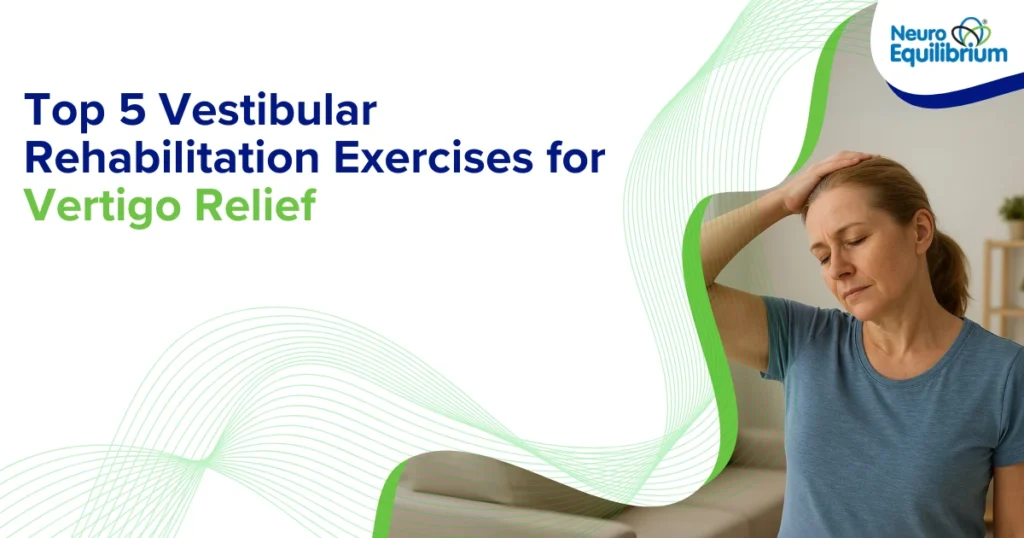You know how disconcerting dizziness or vertigo can be, especially when you have been living with it. The positive side is that exercises can retrain your brain and body to regain balance. A vertigo exercise chart can act as a step-by-step manual that is easy to follow at home or with a therapist’s guidance.
In this article, you will understand how your balance system works, how vestibular exercises chart techniques improve coordination, and what to expect when using a vertigo chart to monitor your recovery.
The Three Key Systems That Help Maintain Balance
- Inner Ear (Vestibular System): Senses movement and position.
- Eyes (Visual System): Reports on the environment.
- Muscles and Joints (Proprioceptive System): Provide information to the brain regarding body position.
The inner ear plays the central role since it sends signals to your brain to maintain balance even when you move. When this system is impaired by infection, inflammation, or displaced calcium crystals (in BPPV), you feel dizzy or experience spinning sensations.
Know More About Vertigo
What Is a Vertigo Exercise Chart?
A vertigo exercise chart is a structured visual or written guide that explains what to do, how to perform each movement safely, and how often to repeat them. Consider it your personal vestibular exercises chart to practice balance training and track progress.
These exercises are customized based on the diagnosis made by your doctor or therapist. However, several common examples of vertigo exercise at home routines include:
- Gaze Stabilization (VOR Exercises)
- Balance Training
- Canalith Repositioning Maneuvers (Epley or Semont)
- Habituation Exercises
You can also refer to vertigo exercises images for visual guidance on how each movement should be performed.
Vertigo Exercise Chart: Step-by-Step Guide
Some of the most effective vertigo exercises at home practices to treat dizziness and balance disorders are listed below. Each section explains the purpose, steps, and safety tips to help you follow the vertigo exercise chart effectively.
1. Gaze Stabilization (VOR Exercises)
Purpose: To train the eyes and inner ear to work together, improving visual stability during head movement.
Steps:
- Sit comfortably in a chair.
- Place a small target (like a letter on a sticky note) at eye level 3–4 feet away.
- Fix your eyes on the target and move your head side to side.
- Repeat for 10–15 seconds, rest, then move your head up and down.
- Begin with 3 repetitions in each direction, gradually increasing over time.
These steps can be tracked easily through a vestibular exercises chart or vertigo exercises images for accuracy.
2. Balance Training
Purpose: To improve overall stability and reduce unsteadiness while standing or walking.
Steps:
- Keep your arms at your sides or hold onto a stable surface if needed.
- Try standing still for 30 seconds, repeat 3 times.
- Move to heel-to-toe stance for 20–30 seconds, switch feet, and repeat.
- Walk in a straight line heel-to-toe for 10 steps.
- As you progress, practice on a slightly uneven surface like a yoga mat.
This section of the vertigo exercise chart is especially beneficial for people who prefer vertigo exercise at home without equipment.
3. Habituation Exercises
Purpose: To reduce sensitivity to movements or positions that trigger dizziness.
Steps (example for dizziness when bending forward):
- Sit upright in a chair.
- Slowly bend forward until nearly touching your knees.
- Hold for 30 seconds or until the dizziness subsides.
- Return to upright and rest for 30 seconds.
- Repeat 5–10 times, 2–3 times daily.
Gradual exposure through vertigo exercise at home helps the brain adapt, improving tolerance and reducing episodes of dizziness.
Safety Guidelines for Using a Vertigo Chart
- Start Small: Begin with fewer repetitions.
- 2-Point Rule: Don’t let dizziness increase by more than 2 points on a 0–10 scale.
- Work in a Safe Area: Stay close to a wall or firm support.
- Take Breaks: Allow your brain to adjust between sessions.
- Stop if Needed: Discontinue if you experience severe dizziness, ear fullness, or hearing loss.
These safety tips are often included in vestibular exercises chart handouts and vertigo exercises images to ensure proper posture and motion.

Clinic vs. Home Exercises
A vertigo exercise chart is useful for daily vertigo exercise at home, while clinic-based programs use specialized equipment to measure progress and adjust therapy. Combining both can offer the fastest and most effective recovery.
How Long Does Recovery Take?
For most patients, it takes about 4–6 weeks to notice improvements with consistent use of the vertigo exercise chart and daily practice of vertigo exercise at home. Recovery may vary depending on age, medical history, and cause of vertigo.
Final Thoughts
A Vertigo Exercise Chart is more than a list of movements, it’s a recovery roadmap. With consistent use of vestibular exercises chart techniques, supported by vertigo exercises images, you can rebuild balance, reduce dizziness, and regain confidence in daily life.
At NeuroEquilibrium, our specialists create personalized exercise plans and provide detailed vertigo exercise charts to ensure each patient’s treatment is safe, effective, and tailored for lasting recovery.
1. Who should use a vertigo exercise chart?
Patients with dizziness, a feeling of imbalance, or known to have a disorder of the vestibular system should only use it under the advice of a doctor or therapist.
2. What types of exercises are included?
The majority of charts include gaze stabilization, balance training, habituation, and canalith repositioning procedures such as the Epley of BPPV.
3. How often should I practice these exercises?
Once- twice a day, although the frequency is determined by your condition and tolerance. Always listen to your doctor.
4. How long does it take to see results?
Recovery can take 4-6 weeks depending on the cause and health, but patients can improve making consistent use of it.
5. Are vertigo exercises safe to do at home?
Yes, when it is done cautiously in a secure place.. Discontinue in case of improvement of symptoms or emergence of new problems.
















